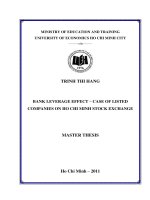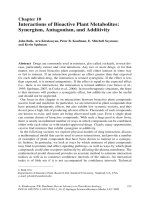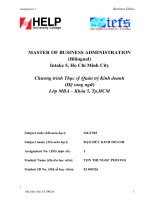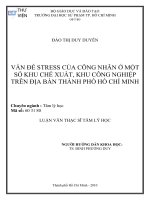Salt stress alleviation of chamomile plant by mycorrhizal fungi and salicylic acid - TRƯỜNG CÁN BỘ QUẢN LÝ GIÁO DỤC THÀNH PHỐ HỒ CHÍ MINH
Bạn đang xem bản rút gọn của tài liệu. Xem và tải ngay bản đầy đủ của tài liệu tại đây (209.54 KB, 7 trang )
<span class='text_page_counter'>(1)</span><div class='page_container' data-page=1>
<i><b>Int.J.Curr.Microbiol.App.Sci </b></i><b>(2017)</b><i><b> 6</b></i><b>(10): 5099-5111 </b>
5099
<b>Original Research Article </b>
<b>Salt Stress Alleviation of Chamomile Plant by </b>
<b>Mycorrhizal Fungi and Salicylic Acid </b>
<b>Ragia M. Mazrou* </b>
Horticulture Department, Faculty of Agriculture, Menoufia University, Shibin El-Kom, Egypt
<i>*Corresponding author </i>
<i> </i>
<i><b> </b></i> <i><b> </b></i><b>A B S T R A C T </b>
<i><b> </b></i>
<b>Introduction </b>
Chamomile (<i>Matricaria chamomilla, </i>L<i>) </i>plant,
belonging to Asteraceae family, has been
cultivated in arid and semi-arid regions
(Renuka, 1992). Chamomile medicinal
compounds make it one of the highest
consuming medicinal plants that have been
largely recognized (Farkoosh <i>et al., </i>2011).
The main constituents of chamomile volatile
oil are chamazulen and bisabolol that are used
widely in pharmaceutical and flavoring
industries (Glambosi and Holm, 1991).
Chamomile volatile oil has been reported to
be used as a carminative, antiseptic, sedative
and anti-inflammatory (Avallone <i>et al., </i>2000).
Salinity is the major problem in different
counties in Arab lands (Ruiz-Lozano <i>et al., </i>
2001) and hence the sustainable production in
many areas is at risk due to soil salinization
(Rengasamy, 2006). The adverse effects of
salinity not only observed on the growth and
development but also decrease the
productivity (Giri <i>et al., </i>2003).
Salt stress negatively affected the vegetative
growth characteristics and dry weight of
several plants (Shoresh <i>et al., </i>2011; Asrar and
Elhindi, 2011). Dadkhah (2010) found that
the vegetative growth characters and flower
yield of chamomile were decreased due to
salinity however volatile oil was increased at
the same salinity level. Under salt stress
condition, RWC and chlorophyll content were
<i>International Journal of Current Microbiology and Applied Sciences </i>
<i><b>ISSN: 2319-7706</b></i><b> Volume 6 Number 10 (2017) pp. 5099-5111 </b>
Journal homepage:
This experiment was carried out to study the impact of arbuscular mycorrhizal fungi
(AMF) inoculation and/or salicylic acid (SA) treatments on salt stress mitigation on
chamomile plant. Salinity levels used in this study were 0, 150 and 300 mM NaCl and SA
was used at 0, 0.2 and 0.4 mM. Under salt stress condition, the plant height, main branch
number and relative water content (RWC) were significantly reduced compared to the
control. Otherwise, the volatile oil percentage was improved while the volatile oil yield
was reduced under salinity treatments. Salinity also decreased the chlorophyll content, N,
P, K, percentages and membrane stability index (MSI) however; total soluble sugars (TSS)
and proline content were increased relative to the control. On the other hand, SA or AMF
treatments mitigated the abovementioned adverse effects of salinity. The accumulation of
proline and maintaining the membrane stability as a result of SA or AMF treatments are
suggested to play important roles in chamomile defense against salinity. To mitigate the
adverse effects of salinity on chamomile plant, treatment of SA or AMF inoculation
treatment was recommended.
<b>K e y w o r d s </b>
Chamomile,
Salinity,
Mycorrhiza,
Chlorophyll,
Proline,
Volatile oil
<i><b>Accepted: </b></i>
24 September 2017
<i><b>Available Online:</b></i>
10 October 2017
</div>
<span class='text_page_counter'>(2)</span><div class='page_container' data-page=2>
<i><b>Int.J.Curr.Microbiol.App.Sci </b></i><b>(2017)</b><i><b> 6</b></i><b>(10): 5099-5111 </b>
5100
decreased (Tuna <i>et al., </i>2008) however; total
soluble sugars, proline content, membrane
permeability and MDA were increased
(Shoresh <i>et al., </i>2011; Celik and Atak, 2012;
Hassan <i>et al., </i>2017).
Several strategies have been adopted to
mitigate the adverse effects of salinity and
efforts are made to explore the mechanisms of
salinity tolerance. Arbuscular myccorrhizal
fungi (AMF) have been reported as one of the
most widespread strategies to improve the
tolerance of environmental stresses
(Brachmann and Parniske, 2006). AMF
inoculation improved the growth and volatile
oil content of fennel (Kapoor <i>et al., </i>2004) and
chamomile (Farkoosh <i>et al., </i>2011, Ali and
Hassan, 2014). AMF application also
improved the yield of various plants (Giri <i>et </i>
<i>al., </i>2003; Sannazzaro <i>et al., </i>2007; Colla <i>et </i>
<i>al., </i>2008). AMF application positively affects
the host plant on photosynthetic pigments,
phosphorous content and flower quality and
hence mitigates the stress (Asrar and Elhindi,
2011). AMF inoculation maintained the RWC
(Sheng <i>et al., </i>2008), improved the chlorophyll
content (Giri <i>et al., </i>2003; Colla <i>et al., </i>2008)
and increased the accumulation of proline
(Sharifi <i>et al., </i> 2007) compared with the
control.
Salicylic acid (SA) is considered as a plant
growth regulator, that plays an important role
in regulating the photosynthesis and improves
the plant growth and development under
salinity (Esan <i>et al., </i> 2017) therefore, it
alleviates the adverse effects of environmental
stresses (Bideshki <i>et </i> <i>al., </i> 2010). SA
application has been reported to induce the
salt stress tolerance (Jayakannan <i>et al., </i>2015).
The growth, yield and volatile oil components
of rosemary plants were significantly
increased due to SA foliar application relative
to the control (Hassan <i>et al., </i>2017). To date,
there was no enough information about the
mitigation of negative effects of salinity on
chamomile plant using AMF or SA. It is very
important to investigate the physiological and
biochemical processes of this plant under salt
stress. Therefore, this study aimed to assess
the different mechanisms by which AMF
symbiosis and SA can protect the chamomile
plant against salinity.
<b>Materials and Methods </b>
<b>Plant material </b>
This pot experiment was carried out at the
experimental farm of Faculty of Agriculture,
Menoufia University during 2014/2015 and
2015/2016 seasons. Chamomile seeds were
sown at September 1st in the nursery in both
seasons and after 45 days; seedlings were
transplanted into (30 x 20 cm) pots containing
sandy soil. The soil was analyzed and the
physical properties were (sand, 80.20 %, silt
6.90 % and clay 12.90 %). The chemical
properties of soil were (OM, 0.12 %, pH,
8.06, Total CaCO3, EC, 2.11 dsm-1, 0.77 %,
Na+, 3.22 (meqL-1), SO4-2, 44.52 (meqL-1),
Ca+2, 42.17 (meqL-1), Cl-, 0.57 (meqL-1),
HCO3, 2.08 (meqL-1), total N+, PO4-3, K+ were
0.15, 0.032 and 0.039 %, respectively).
<b>Salinity treatment </b>
Salinity treatments were 0, 150 and 300 mM
NaCl. Plants subjected to saline irrigation
water after 21 days from transplanting. To
prevent shock to plants, salinity started with
50 mM saline water and was increased by 50
mM every other day until reaching the
required salinity level.
</div>
<span class='text_page_counter'>(3)</span><div class='page_container' data-page=3>
<i><b>Int.J.Curr.Microbiol.App.Sci </b></i><b>(2017)</b><i><b> 6</b></i><b>(10): 5099-5111 </b>
5101
<b>Mycorrhizae and SA treatments </b>
The mycorrhizal fungi were isolated from the
experimental farm of Faculty of Agriculture,
Shibin El-Kom, Menofiya University. In pot
culture medium containing loam:sand (1:1),
AMF were grown on roots of basil (<i>Ocimum </i>
<i>basilicum</i> L.). Then, AMF inocula was put
below the surface of the soil by 3 cm (before
transplanting) to produce mycorrhizal pants as
reported by Asrar and Elhindi (2011).
Otherwise, control soil not inoculated with
AMF but has a similar culture. Salicylic acid
(SA) was dissolved in 100 mL dimethyl
sulfoxide and 0, 0.2 and 0.4 mM were
prepared using distilled water containing 0.02
% Tween 20. SA was applied as foliar spray
and the application was started one week after
salinity treatment. Foliar spraying with SA
was weekly applied in the early morning.
Control plants were sprayed with distilled
water containing 0.02 % Tween 20 only. The
applied treatments were arranged in split plot
design with four replicates each. In the main
plots, salinity treatments were randomly
distributed while AMF and SA treatments
were in the sub plots.
<b>Growth and yield evaluation </b>
The plant height (cm), number of main
branches/plant and flower dry yield/plant
were recorded in this experiment.
<b>Volatile oil percentage and yield per plant </b>
Water distillation method was used for
volatile oil extraction and determine the oil
percentage in flowers using a clevenger-type
apparatus described in British Pharmacopea
(1963) using the following equation :Volatile
oil percentage = oil volume in the graduated
tube / fresh weight of sample x 100. Finally,
the oil yield/plant was calculated in relation to
the dry flower yield.
<b>Relative water content (RWC) </b>
Herb RWC was assessed using the following
relationship according to Weatherley (1950):
(Wfresh-Wdry) / (Wturgid-Wdry) x 100, where
Wfresh is the sample fresh weight, Wturgid is the
sample turgid weight after saturating with
distilled water for 24 h at 4 °C, and Wdry is the
oven-dry (70 °C for 48 h) weight of the
sample.
<b>Chlorophyll content </b>
The chlorophyll content of leaf samples were
determined by the method of Metzner <i>et al., </i>
(1965). Leaf discs (0.2 g) were homogenized
in 50 mL acetone (80 %). A cheese cloth was
used for slurry straining and the extract was
centrifuged at 15000 <i>g</i> for 10 min. The optical
density of the acetone extract was
spectrophotometrically observed at 663 nm
for chlorophyll (a) and 645 nm for
chlorophyll (b) and were expressed in mg g-1
fresh weight.
<b>Total soluble sugars </b>
Total soluble sugars were evaluated in leaf
samples using the method of Dubois <i>et al., </i>
(1956).
<b>Proline determination </b>
</div>
<span class='text_page_counter'>(4)</span><div class='page_container' data-page=4>
<i><b>Int.J.Curr.Microbiol.App.Sci </b></i><b>(2017)</b><i><b> 6</b></i><b>(10): 5099-5111 </b>
5102
calculated based on a standard curve and was
expressed as µmol g-1 FW.
<b>Membrane stability index (MSI) </b>
MSI was assessed by the method of Sairam <i>et </i>
<i>al., </i>(1997). Briefly, 2 leaf samples (0.2 g)
each were taken and put in 20 mL of double
distilled water in two different 50 mL flasks.
The first one was kept at 40 °C for 30 min
while the second one was kept at 100 °C in
boiling water bath for 15 min. The electric
conductivity of the first (C1) and second (C2)
samples was investigated with a conductivity
meter. The ions leakage was expressed as the
membrane stability index according to the
following formula, MSI = [1- (C1/C2)] X 100.
<b>Leaf mineral content </b>
To determine nutrient content, the wet
digestion procedure of dried sample (0.5 g)
was performed according to Jackson (1978).
Nitrogen percentage in leaves was
investigated in the digestion by the
micro-Kjeldhl method (Black <i>et al., </i> 1965).
Phosphorus, potassium and sodium
percentages were determined as described by
Jackson (1978).
<b>Statistical analysis </b>
The results of this study were analyzed using
MSTAT program, USA. Analysis of variance
(ANOVA) was performed and means were
separate using LSD test at a significance level
of 0.05.
<b>Results and Discussion </b>
<b>Plant height </b>
The plant height of chamomile was
significantly decreased due to salinity
treatments. Increasing the level of salinity
further decreased the plant height in both
seasons. However, application of SA or AMF
alleviated the reduction in plant height
occurred by both salinity levels and SA
treatment at 0.4 mM was superior to 0.2 mM
or AMF treatments. Under higher salinity
level, there were no significant differences
between SA and AMF treatments in
alleviation the plant height reduction.
<b>Branch number </b>
From data presented in Table (1) it could be
noticed that the branch number was gradually
decreased with increasing salinity level and
the lowest branch number was obtained by
300 mM NaCl treatment. Meanwhile, SA or
AMF application enhanced the branch
number of chamomile grown under salinity
more so with SA at 0.4 mM or AMF
inoculation in the two experimental seasons.
<b>Relative water content (RWC) </b>
The RWC was significantly increased as a
result of SA or AMF treatments compared
with the control. However, it was decreased
when plants grown under salinity in both
seasons (Table 1). Otherwise, the reduction in
RWC due to salinity was retarded by applying
SA or AMF treatments. In this concern, using
SA at 0.4 mM or AMF was superior to SA at
0.2 mM in both seasons.
<b>Dry flower yield </b>
</div>
<span class='text_page_counter'>(5)</span><div class='page_container' data-page=5>
<i><b>Int.J.Curr.Microbiol.App.Sci </b></i><b>(2017)</b><i><b> 6</b></i><b>(10): 5099-5111 </b>
5103
completely alleviated the reduction of flower
yield caused by salinity, however under 300
mM the reduction in flower yield was 4.21
and 3.91 % in the first season and was 4.14
and 4.78 % in the second one when SA at 0.4
mM or AMF treatments were applied,
respectively.
<b>Volatile oil percentage and yield </b>
The volatile oil percentage was enhanced
when plants grown under salinity compared
with non-stressed plants and the highest
salinity level produced higher volatile oil
percentage in both seasons (Table 2).
Additionally, SA or AMF treatments
significantly improved the volatile oil
percentage relative to the control in both
seasons (Table 2). When chamomile plants
grown under 300 mM salinity level and
treated with SA at 0.4 mM or AMF treatments
the highest percentage of volatile oil was
recorded.
On the other hand, the volatile oil yield/plant
was significantly decreased due to increasing
salinity level from 150 to 300 mM. However,
SA or AMF applications significantly
increased the oil yield relative to the control.
Furthermore, the reduction in oil yield due to
salinity was retarded when SA or AMF
treatments were applied (Table 2).
Chamomile plants grown under 150 or 300
mM salinity levels and applied with SA at 0.4
mM or AMF treatments the highest volatile
oil yield was recorded.
<b>Chlorophyll content </b>
Increasing salinity levels decreased the
chlorophyll content of chamomile leaves
compared with the non-stressed plants in both
seasons (Table 3). SA or AMF treatments
improved the chlorophyll content when
applied solely without salt stress and their
applications under stress condition retarded
the reduction observed in chlorophyll due to
salinity in both experimental seasons and
maintained higher chlorophyll content even
under salinity.
<b>Total soluble sugar (TSS) </b>
It is very clear from data presented in Table
(2) that TSS in chamomile herb was
significantly enhanced when plants grown
under any salinity level and the increase in
salinity level, the increase in TSS content.
Also, SA or AMF increased TSS compared
with the control in both seasons. The highest
TSS percentages were observed when plants
were grown under 300 mM of salinity and
treated with 0.4 mM SA or AMF inoculation.
<b>Proline content </b>
The proline accumulation in chamomile herb
was increased with increasing salinity level
from 150 mM to 300 mM in both seasons.
Under non-stress condition, there were no
significant differences among SA or AMF
treatments and control (Table 4). Higher
proline accumulation was observed when
plants grown under salinity and treated with
SA or AMF in both seasons..
<b>Membrane stability index (MSI) </b>
It is obvious from data in Table (4) that in
non-stressed plants, SA or AMF applications
significantly improved MSI compared with
the control. Meanwhile, MSI was
significantly reduced with increasing salinity
level from 150 to 300 mM in both seasons.
Otherwise, SA or AMF treatments prevented
the reduction in MSI caused by salinity.
<b>Nutrient elements </b>
</div>
<span class='text_page_counter'>(6)</span><div class='page_container' data-page=6>
<i><b>Int.J.Curr.Microbiol.App.Sci </b></i><b>(2017)</b><i><b> 6</b></i><b>(10): 5099-5111 </b>
5104
<b>Table.1</b> Effects of arbuscular mycorrhizal fungi (AMF) and salicylic acid (SA) on plant height,
branch number/plant and relative water content (RWC) of chamomile plant grown under salt
stress
<b>Treatments</b> <b>2014/2015 season</b> <b>2015/2016 season</b>
<b>Salinity</b> SA and AMF Plant
height (cm)
Branch
number/plant
RWC
(%)
Plant height
(cm)
Branch
number/plant
RWC
(%)
<b>0</b> 0 39.65 8.33 79.87 38.48 8.47 80.28
0.2 mM 42.19 9.57 81.65 42.36 9.62 81.89
0.4 mM 46.22 10.46 84.32 45.17 10.67 84.66
AMF 43.53 9.62 83.74 43.88 9.84 83.94
<b>150 mM</b> 0 33.66 6.24 70.47 32.45 6.47 71.18
0.2 mM 35.47 7.82 75.88 35.17 7.95 75.33
0.4 mM 37.75 8.45 78.92 37.45 9.33 79.68
AMF 35.41 8.16 80.77 35.64 8.56 81.67
<b>300 mM</b> 0 25.27 5.74 63.55 24.68 5.87 65.36
0.2 mM 29.67 6.63 70.76 29.47 6.77 71.48
0.4 mM 29.86 7.49 75.86 29.88 7.89 75.64
AMF 30.72 7.33 76.33 30.15 7.43 76.53
<b>LSD 0.05</b> 1.85 0.67 2.34 1.79 0.63 2.27
<b>Table.2</b> Effects of arbuscular mycorrhizal fungi (AMF) and salicylic acid (SA) ondry flower
yield, volatile oil percentage and oil yield / plant of chamomile grown under salt stress
<b>Treatments</b> <b>2014/2015 season</b> <b>2015/2016 season</b>
<b>Salinity</b> SA and
AMF
Dry flower
yield (g/plant)
Volatile
oil (%)
Oil yield
(mL/ plant)
Dry flower
yield (g/plant)
Volatile
oil (%)
Oil yield
(mL/ plant)
<b>0</b> 0 49.83 0.59 0.29 50.67 0.58 0.29
0.2 mM 55.27 0.68 0.38 56.37 0.69 0.39
0.4 mM 62.94 0.70 0.44 63.75 0.71 0.45
AMF 63.56 0.69 0.44 64.11 0.70 0.45
<b>150 mM</b> 0 39.94 0.63 0.25 40.73 0.64 0.26
0.2 mM 47.52 0.72 0.34 48.15 0.71 0.34
0.4 mM 52.18 0.73 0.38 52.88 0.74 0.39
AMF 53.49 0.72 0.39 53.19 0.73 0.39
<b>300 mM</b> 0 21.22 0.68 0.14 22.17 0.66 0.15
0.2 mM 44.68 0.79 0.35 44.39 0.76 0.34
0.4 mM 47.73 0.81 0.39 48.57 0.82 0.40
AMF 47.88 0.80 0.38 48.25 0.81 0.39
</div>
<span class='text_page_counter'>(7)</span><div class='page_container' data-page=7>
<i><b>Int.J.Curr.Microbiol.App.Sci </b></i><b>(2017)</b><i><b> 6</b></i><b>(10): 5099-5111 </b>
5105
<b>Table.3</b> Effects of arbuscular mycorrhizal fungi (AMF) and salicylic acid (SA) on chlorophyll
content and total soluble sugar (TSS) of chamomile grown under salt stress
<b>Treatments</b> <b>2014/2015 season</b> <b>2015/2016 season</b>
Chlorophyll content
(mg g-1 FW)
TSS
(%)
Chlorophyll content
(mg g-1 FW)
TSS
(%)
<b>Salinity</b> SA and AMF
<b>0</b> 0 0.95 8.39 0.92 8.27
0.2 mM 1.01 8.66 0.99 8.39
0.4 mM 1.15 10.76 1.12 10.68
AMF 1.09 10.91 1.11 10.84
<b>150 mM</b> 0 0.83 8.81 0.84 9.11
0.2 mM 0.94 10.30 0.96 11.23
0.4 mM 1.03 11.87 1.01 12.17
AMF 0.98 12.04 0.98 11.98
<b>300 mM</b> 0 0.78 9.73 0.80 9.88
0.2 mM 0.82 11.42 0.82 11.36
0.4 mM 0.97 13.58 0.94 13.67
AMF 0.96 13.80 0.95 13.58
<b>LSD 0.05</b> 0.13 0.74 0.12 0.72
<b>Table.4</b> Effects of arbuscular mycorrhizal fungi (AMF) and salicylic acid (SA) on proline
content and membrane stability index (MSI) of chamomile grown under salt stress
<b>Treatments</b> <b>2014/2015 season</b> <b>2015/2016 season</b>
Proline
(µmol g-1 FW)
MSI (%) Proline
(µmol g-1 FW)
MSI (%)
<b>Salinity</b> SA and AMF
<b>0</b> 0 1.80 79.58 1.81 78.33
0.2 mM 1.82 82.67 1.84 82.24
0.4 mM 1.81 83.53 1.83 82.17
AMF 1.83 83.16 1.84 82.87
<b>150 mM</b> 0 1.87 71.67 1.91 72.25
0.2 mM 1.98 78.68 2.04 78.62
0.4 mM 2.23 80.94 2.17 81.12
AMF 2.19 82.11 2.16 82.67
<b>300 mM</b> 0 1.99 69.27 2.11 68.70
0.2 mM 2.20 75.13 2.22 75.55
0.4 mM 2.19 77.84 2.29 76.89
AMF 2.21 77.89 2.27 78.12
</div>
<!--links-->
THE INFORMAL SECTOR IN SOLID WASTE MANAGEMENT IN DEVELOPING COUNTRIES SUSTAINABILITY EFFECTS OF FORMALISATION CONSIDERING HO CHI MINH CITY – VIETNAM AS AN EXAMPLE
- 112
- 593
- 5








